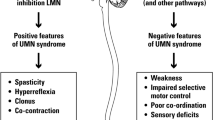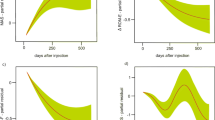Abstract
Purpose
To prospectively evaluate long-term effects of repeated botulinum toxin A (BTX-A) injections in children with cerebral palsy (CP).
Methods
Repeated injections of BTX-A were offered to children with CP, according to clinical indications, for a maximum of four injections within a period of two years. Injections were administered into lower extremity muscles of 26 consecutive children (age 3.7 ± 1.2 years, 16 boys) with hemiplegic or diplegic CP. Clinical assessments before and one month following each injection included a gross motor function measure (GMFM), a modified Ashworth scale, and range-of-motion of knee extension and ankle dorsiflexion.
Results
Twelve children received two injections, six received three injections, five received one injection, and three received four injections. The most common reason for discontinuing treatment was the need for orthopedic surgery (n = 17). A long-term effect was demonstrated by a significant increase of the GMFM score before the first injection compared with the last injection for each patient (P < 0.0001). There was no comparable change in the muscle tone or range-of-motion. The mean rate of GMFM change during the study was significantly higher than literature norms for CP children (13.2 vs. 5.37 per year, respectively, P < 0.01). The increase of the GMFM score before and one-month after injection (short-term effect) was significantly higher after the first injection than after the last injection (P < 0.05). Similar results were found for the Ashworth scale and popliteal angle.
Conclusions
Botulinum toxin A injections have a long-term effect on gross motor function in children with CP even though the effect on muscle tone is short-term. The effect apparently declines with repeated injections, with most children benefitting from 2 to 3 injections.

Similar content being viewed by others
References
Cosgrove AP, Corry IS, Graham HK (1994) Botulinum toxin in the management of the lower limb in cerebral palsy. Dev Med Child Neurol 36:386–396
Calderon-Conzalez R, Calderon-Sepulveda R, Rincon-Reyes M, Garcia-Ramirez J, Mino-Arango E (1994) Botulinum toxin A in management of cerebral palsy. Pediatr Neurol 10:284–288
Gooch JL, Sandell TV (1996) Botulinum toxin for spasticity and athetosis in children with cerebral palsy. Arch Phys Med Rehabil 77:508–511
Koman LA, Mooney JF 3rd, Smith BP, Goodman A, Mulvaney T (1994) Management of spasticity in cerebral palsy with botulinum-A toxin: report of a preliminary, randomized, double-blind trial. J Pediatr Orthop 14:299–303
Boyd R, Graham HK (1997) Botulinum toxin A in the management of children with cerebral palsy: indications and outcome. Eur J Neurol 4:S15–S22
Wong V (1998) Use of botulinum toxin injection in 17 children with spastic cerebral palsy. Pediatr Neurol 18:124–131
Corry IS, Cosgrove AP, Duffy CM, Taylor TC, Graham HK (1999) Botulinum toxin A in hamstring spasticity. Gait Posture 10:206–210
Ade-Hall RA, Moore AP (2004) Botulinum toxin type A in the treatment of lower limb spasticity in CP (Cochrane review) In: The Cochrane library, issue 1. Wiley, Chichester
Koman LA, Brashear A, Rosenfeld S, Chambers H, Russman B, Rang M, Root L, Ferrani E, Garcia de Yebens Prous J, Smith BP, Turkel K, Walcott JM, Molloy PT (2001) Botulinum toxin type a neuromuscular blockade in the treatment of equinus foot deformity in cerebral palsy: a multicenter, open-label clinical trial. Pediatrics 108:1062–1071
Eames NW, Baker R, Hill N, Graham K, Taylor T, Cosgrove A (1999) The effect of botulinum toxin A on gastrocnemius length: magnitude and duration of response. Dev Med Child Neurol 41:226–232
Metaxiotis D, Siebel A, Doederlein L (2002) Repeated botulinum toxin A injections in the treatment of spastic equinus foot. Clin Orthop Rel Res 394:177–185
Sutherland DH, Kaufman KR, Wyatt MP, Chambers HG, Mubarak SJ (1999) Double-blind study of botulinum A toxin injections into the gastrocnemius muscle in patients with cerebral palsy. Gait Posture 10:1–9
Gormley ME, Gaebler-Spira D, Delgado MR (2001) Use of botulinum toxin in pediatric patients with cerebral palsy: a three-center retrospective chart review. J Child Neurol 16:113–118
Watanabe Y, Bakheit AMO, McLellan DL (1998) A study of the effectiveness of botulinum toxin type A (Dysport) in the management of muscle spasticity. Disabil Rehabil 20:62–65
Wong AM, Pei YC, Lui TN, Chen CL, Wang CM, Chung CY (2005) Comparison between botulinum toxin type A injection and selective posterior rhizotomy in improving gait performance in children with cerebral palsy. J Neurosurg 102:385–389
Wood E, Rosenbaum P (2000) The gross motor function classification system for cerebral palsy: a study of reliability and stability over time. Dev Med Child Neurol 42:292–296
Russell DJ, Rosenbaum PL, Cadman DT, Gowland C, Hardy S, Jarvis S (1989) The gross motor function measure: a means to evaluate the effects of physical therapy. Dev Med Child Neurol 31:341–352
Russell DJ, Rosenbaum PL, Avery LM, Lane M (2002) Gross motor function measure (GMFM-66 and GMFM-88) user’s manual. Mac Keith Press, Cambridge University Press, (Appendix 4) pp 204–208
Graham HK, Aoki KR, Autti-Ramo I, Boyd RN, Delgado MR, Gaebler-Spira DJ, Gormley ME, Guyer BM, Heinen F, Holton AF, Matthews D, Molenaers G, Motta F, Garcia Ruiz PJ, Wissel J (2000) Recommendations for the use of botulinum toxin type A in the management of cerebral palsy. Gait Posture 11:67–79
Gough M, Fairhurst C, Shortland AP (2005) Botulinum toxin and cerebral palsy: time for reflection? Dev Med Child Neurol 47:709–712
Koman AL, Mooney JF 3rd, Smith BP, Walker F, Leon JM (2000) Botulinum toxin type A neuromuscular blockade in the treatment of lower extremity spasticity in cerebral palsy: a randomized, double-blind, placebo-controlled trial. BOTOX Study Group. J Pediatr Orthop 20:108–115
Ubhi T, Bhakta B, Ives H, Allgar V, Roussounis SH (2000) Randomised double blind placebo controlled trial of the effect of botulinum toxin on walking in cerebral palsy. Arch Dis Child 83:481–487
Massin M, Alllington N (1999) Role of exercise testing in the functional assessment of cerebral palsy children after botulinum A toxin injection. J Pediatr Orthop 19:362–365
Fattal-Valevski A, Giladi N, Domanievitz D, Zuk L, Masterman R, Harel S, Wientroub S, Hayek S (2002) Parameters for predicting favorable responses to botulinum toxin in children with cerebral palsy. J Child Neurol 17:272–277
Herrmann J, Geth K, Mall V, Bigalke H, Schulte Monting J, Linder M, Kirschner J, Berweck S, Korinthenberg R, Heinen F, Fietzek UM (2004) Clinical impact of antibody formation to botulinum toxin A in children. Ann Neurol 55:732–735
Acknowledgments
We thank Esther Eshkol for her editorial assistance, and the children and their parents for their time and goodwill. This study was supported by an educational grant from Allergan Inc. UK.
Author information
Authors and Affiliations
Corresponding author
About this article
Cite this article
Fattal-Valevski, A., Domenievitz, D., Giladi, N. et al. Long-term effect of repeated injections of botulinum toxin in children with cerebral palsy: a prospective study. J Child Orthop 2, 29–35 (2008). https://doi.org/10.1007/s11832-007-0075-8
Received:
Accepted:
Published:
Issue Date:
DOI: https://doi.org/10.1007/s11832-007-0075-8




